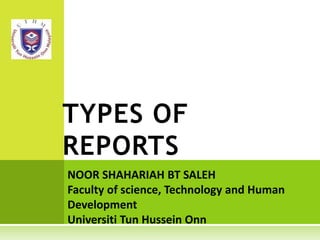
3. TYPES OF REPORTS.pptx
- 1. TYPES OF REPORTS NOOR SHAHARIAH BT SALEH Faculty of science, Technology and Human Development Universiti Tun Hussein Onn
- 2. WHAT IS A REPORT?
- 3. A report is A VERY FORMAL DOCUMENT that is written for a variety of purposes, generally in the SCIENCES, SOCIAL SCIENCES, ENGINEERING and BUSINESS disciplines.
- 4. Ungroup to move, recolor, or delete levels. •A report also
- 6. ANALYTICAL PERSUASIVE INFORMAL □Inform or instruct present information □Provide details of events, activities or conditions □No analysis on situation, no conclusion, no recommendations □To solve problems □Information is analysed □Conclusions are drawn and recommendations are made. □An extensive of analytical reports: main focus is to sell an idea, a service, or product □Example:proposal REPORT CAN COME IN THE TYPES OF:
- 8. 1. Periodic operating reports- To monitor and control production, sales, shipping, service etc. 2. Situational report- To describe one-time event (trips, conferences, seminars) 3. Investigative/informational - To study problems and supply facts – with little analysis
- 9. 4. Compliance - To respond to government agencies and laws (to show obedient). 5. Justification/ recommendation - To recommend on management and as tools to solve problems and make decisions. 6. Yardstick - To establish criteria and evaluate alternatives by measuring against the “yardstick” criteria.
- 10. 7. Research reports - To study problems scientifically by analysing a problem, developing hypotheses, collecting data, analysing data, and drawing conclusions. 8. Proposals - To offer to solve problems, investigate ideas, or sell products and services. 9. Incident/ accident -To give information on accident that happens at the work place.
- 11. SHORT REPORT
- 12. FINANCIAL PROGRESS INSTRUCTION MANUALS COST-BENEFIT ANALYSIS FIELD STUDY INCIDENT/ ACCIDENT LABORATORY TYPES OF SHORT REPORTS
- 13. The importance of short reports 1. It tells whether Work is being completed Schedules are being met Costs have been controlled Sales projections are being met Unexpected problems have been solved
- 14. 2. Provides organised relevant data of any topic- money, travel, time, equipment. 3. It is practical and straight to the point. 4. It is written to subordinates, employers, vendors and clients.
- 15. Short reports are sent as Memo (within organisation) Letters (for clients)
- 16. Organising Short Reports Help the reader by using: Bullets or numbers Headings Visual (when necessary)
- 17. There are two systems: The conventional system: 1. A report with two layers of heading 2. Takes Arabic numerals -1,2,3 3. The subsections – (a), (b), (c) 4. Third layer – (i), (ii), (iii) The decimal (Dewey) system: 1. The numerals are separated into various levels of heading. 1.0………. 1.1……….. 1.1.1…….. 1.1.2……. 1.1.2.1…….
- 18. The conventional system The decimal system
- 19. Include those information: Purpose Findings Conclusions Recommendations
- 20. Purpose 1. Start with the reason of writing and what you will discuss. 2. Provide summary of key events and details. Findings 1. Longest part of the report and contains the collected data – prices, personnel, equipment, events 2. Gather the data from the research- personnel observations, interviews 3. Provide the results
- 21. Conclusion 1. Tells the meaning of the data 2. Summarise what happened: review the action taken, explain the outcome Recommendations 1. Inform the specific actions that the company or client should take – market new products, hire more staff etc. 2. Based on the collected data and the conclusions
- 22. ACCIDENT / INCIDENT REPORTS Document unexpected events. Employers, government inspectors, insurance agents and attorneys – must be informed. Can be submitted as a memo or form.
- 23. When? An accident A machine breakdown A delivery delay A cost overrun A product slowdown Example
- 24. WHEN TO WRITE A SHORT REPORT? Engineering □To outline a proposal of a project □To report the progress of a project □to present research and findings from a project □To detail the technical aspects of innovations □To present results from a feasibility or cost-benefit analytical study. Education and health science □Practicum reports based on the experiences at practical school or hospital. □Ongoing journal entries are written up into a report at the end of term. Science and some social sciences □Laboratory reports outline, analyse and evaluate results from experiments. □Feasibility studies reports investigate the possibility of something and make recommendations. □Case study reports are usually found in social welfare, social work and psychology.
- 25. LAB REPORTS AND SCIENTIFIC PAPERS Persuade others Detail data, procedures and outcomes Become part of the accepted body of scientific knowledge Provide an archival record
- 26. Format of a typical lab report Title Abstract Introduction Materials and methods Results Discussion References and literature cited
- 27. Lab report template 1. Title A brief, concise, yet descriptive 2. Statement of the problem What question(s) you try to answer? Include any preliminary observations or background information 3. Hypothesis Possible solutions In complete sentence Testable
- 28. 4. Materials – all items used 5. Procedure In a paragraph To be repeated 6. Results (data) Data, observations, or additional notes Attach a separate sheet(s) Label all tables, graphs and charts 7. Conclusions Accept or reject hypothesis Explain the rejection and acceptance Summary of data – highest, lowest, averages Learned things and what can be applied Possible errors occurred
- 29. Example of lab report
- 30. FIELD TRIP REPORT 1. A description of what, when, where, why who and how questions. 2. To learn issues in the real world based on observation and contribution/ participation. 3. Take notes – materials presented, investigations
- 31. Guidelines of work or group project 1. Introduction Venue, aims, what was investigated 2. Field observations Detail explanation on what was observed, comment on the significance Photographs, field sketches Day by day account 3. Conclusions Mention the key issues (bullet points)
- 32. Example of a field trip report
- 33. Assignment 1 Cover
- 34. REFERENCES www3.cutr.usf.edu/...REPORT~1/.../ACC_IN~1.D OC - United States http://www.utem.edu.my/myweb/sani/pdf/micr oc_longreport.pdf